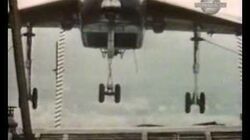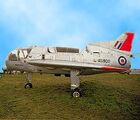.

Short SC. 1 VTOL Experimental Aircraft
The Short SC.1 was the first British fixed-wing vertical take-off and landing (VTOL) aircraft. The SC.1 was designed to study the problems with VTOL flight and the transition to and from forward flight.
.
Data[]
| Category. | Statistic. | |
|---|---|---|
| First flight on. | 1957. | |
| Retired on. | 1971. | |
| Major contractor(s) . | Short Brothers. | . |
| Dose it use nukes or cruse missiles. | It was not decided upon at the time of making so it's a provisional no on those build, but could have changed if more were made later. | |
| Fight ceiling | Service ceiling: 8,000 ft (2,440 m). | |
| Top speed. | 246 mph (214 knots, 396 km/h). | |
| VTOL. | Yes. | |
| Range. | 150 miles (130 NM, 240 km). | |
| Crew. | 1. | |
| Nationality(s). | British. | |
| Class. | Experimental VTOL fighter proto-type. | |
| Rate of climb. | 700 ft/min (3.6 m/s). | |
| Links. | https://www.scalemates.com/kits/946021-whirlykits-wpx72001-short-sc-1, https://commons.wikimedia.org/wiki/Category:Short_SC.1, http://www.aviastar.org/air/england/short_sc-1.php, https://en.wikipedia.org/wiki/Short_SC.1, https://images.search.yahoo.com/search/images;_ylt=A0LEVBfMQRzZWMDc2M-?p=Short+SC.1&fr=yset_chr_cnewtab, http://www.testflyingmemorial.com/1946-70.htm, https://en.wikipedia.org/wiki/Short_SC.1 and http://en.webot.org/?search=Short_SC.1. |
Desinge[]
The Short SC.1 was the first British fixed-wing vertical take-off and landing (VTOL) aircraft. The SC.1 was designed to study the problems with VTOL flight and the transition to and from forward flight. It had the first "fly-by-wire" control system for a VTOL aircraft. It was primary used by the Royal Aircraft Establishment.
- Aerodynamic surfaces and air-jet nozzles controlled electrically via three independent servo-motors (with "three-way parallel" or "triplex" fail-safe operation) in conjunction with three autostabilizer control systems ("full fly-by-wire")
- Hybrid-mode, in which the nozzles were controlled by servo/autostabilizer and the aerodynamic surfaces were linked directly to the manual controls
- Direct mode, in which all controls were linked to the control stick
Modes 1 and 2 were selected on the ground; whenever the autostabilizer was in use, the pilot had an emergency override lever available with which to revert to direct control mode in flight.
The outputs from the three control systems were compared and a "majority rule" enforced, ensuring that a failure in a single system was overridden by the other two (presumably correct) systems. Any failure in a "fly-by-wire" pathway was indicated to the pilot as a warning, which he could either choose to ignore or respond to by switching to direct (manual) control.
History[]
The first SC-1 (XG900) was used until 1971 for VTOL research and is now part of the Science Museum's aircraft collection at South Kensington, London. The second SC-1 (XG905) can be seen at the Flight Experience exhibit at the Ulster Folk and Transport Museum in Cultra, Northern Ireland.



